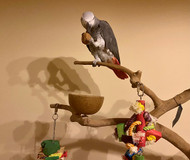Parrot Play Stands, The Good, The Bad and the Ugly
Posted by Parrot Play Stands, Bad Parrot Play Stands, Good Parrot Play Stands, Parrot Training on 9/1/2024
Elaine Henley tells us more about Parrot play stands.
About Elaine Henley
Elaine Henley P.G.Dip CABC
Elaine Henley is registered as a Clinical Animal Behaviourist with the Animal Behaviour and Training Council and a Full Member of the Association of Pet Behaviour Counsellors ? where she is the Treasurer. Working with a variety of species; dogs, cats and Parrots.

Elaine is one of the very few Parrot specialists to have studied their behaviour in the wild and uses this knowledge to help caregivers at home.
Website www.dogbehaviour.org.uk
Facebook www.facebook.com/animalbehaviourclinic
Facebook www.facebook.com/elainehenleyparrotexpert
Limitations
When birds are kept as pets, limitations are often placed on them in terms of social interaction, flight, foraging, access to appropriate species-specific diets and maintenance behaviour such as nest building, bathing and preening.
These limitations may also be a variable for the occurrence of abnormal behaviours such as feather damaging behaviours (FDBs), reproductive behaviours directed towards caregivers, caregiver directed aggression, extreme vocalisation and stereotypic behaviours.
By studying Parrots? behaviour in the wild, we can learn more about what they need and aim to provide this within our household.
So how do they spend their time in the wild? Wild Parrots spend a great deal of their time, foraging for food , preening, chewing, socialising with others and even playing. Parrots have different play styles; they may be acrobats, shredders, chain saws, or a combination of all. In the wild, one rarely observes a solitary Parrot for any significant time.
Flocks
They are mostly to be found in pairs or flocks. Although they may form strong monogamous pair-bonds, wild Parrots are often observed hanging out with others from their own flock, or another flock.
Whilst we don?t know for sure if contact with humans can ever make up for contact with their own species, we do know that being out of a cage for more than eight hours a day and having a minimum of four hours a day contact with a human caregiver, can decrease the risk of Feather Destructive Behaviour by nearly 90%.

In a previous article, I discussed the importance of a Parrot?s cage in terms of providing safety, security and enrichment for those times that for whatever reason they cannot be out of their cage
In this article I will discuss play stands and whether or not they are beneficial or not to a Parrot?s wellbeing.
A google search reveals an eye watering 16,800,000 hits for the term ?Parrot play stands? and images show play stands of a huge variety of shapes, colours and textures. Some are stand alone, some intended to be placed upon a table. All are intended to be a safe space for your Parrot to play, snack or snooze and to give them time away from their cage.
Caregivers
One of the reasons why caregivers are often reluctant to allow free time out of the cage is because of the Parrot?s natural destructive decorative skills. Providing a suitable play stand that accommodates that particular Parrots play style will give them an alternative.

Stand-alone play stands, come in a variety of materials from metal to wood, wheels or not. Whilst metal ones may be chew proof and easier to keep clean, for them to be of any enrichment value to your Parrot you will need to add various toys that may be chewed or picked up by foot.
Play stands made from wooden perches offer chewing possibilities and keep your Parrot?s feet exercised, they too benefit from the addition of toys
Having wheels on either means that you can easily move the stand into whichever room you happen to be in, allowing your Parrot the opportunity to hang out with his flock.
Windows
Furthermore, movable play stands can be placed in front of closed windows, allowing your bird to look outside.
Some smaller play stands are intended to be placed on top of a table, allowing the Parrot to be closer to his flock and take part in flock activities, such as eating dinner together or watching TV etc. As many of us remain working from home, they allow the Parrot to hang out whilst we work.
However, there seems to be a worrying trend amongst some Parrot caregivers, whose birds? wings prevent flying, of restricting their Parrot to either their cage or play stand. Consider how boring and frustrating this must be for the Parrot to be so limited and have little choice of where they perch.

Ideally, Parrot caregivers should have additional play stands or appropriate perches throughout their home allowing their Parrot to move freely between them.
Introduce new things
Most of our Parrots are scared of new things, so if your Parrot has never seen one before, then introduce it gradually to them.
Firstly, let them see it by placing it in a room that they are already familiar with.
Secondly, approach the play stand yourself and interact with toys that are there.
Thirdly, place some favoured treats inside the attached food bowls. Lastly encourage them to step up onto the perch.
So are Parrot play stands beneficial? Absolutely and the more the better!


